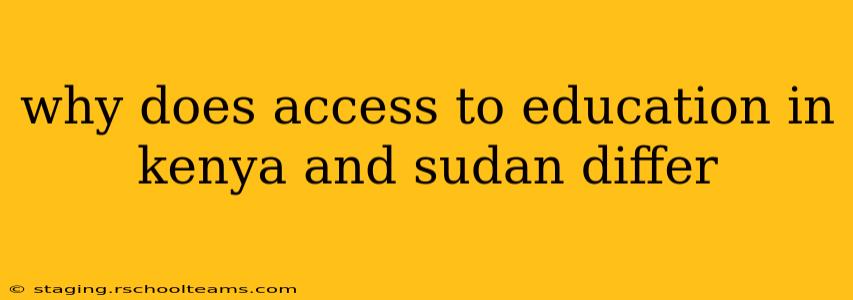Why Does Access to Education in Kenya and Sudan Differ?
Access to education in Kenya and Sudan, while both facing significant challenges, differs dramatically due to a complex interplay of political, economic, social, and geographical factors. While both nations strive for universal education, their progress and the obstacles they encounter vary considerably. This disparity isn't simply a matter of funding; it's a reflection of deep-rooted societal structures and ongoing conflicts.
What are the major factors affecting access to education in Kenya?
Kenya has made significant strides in expanding access to primary education, largely due to the introduction of free primary education in 2003. However, challenges persist, particularly in achieving equitable access across different regions and socio-economic groups. These challenges include:
- Geographical Barriers: Reaching remote and marginalized communities, especially those in arid and semi-arid lands, remains a significant hurdle. Infrastructure limitations (lack of roads, schools, and transportation) prevent children from attending school.
- Socio-economic Factors: Poverty remains a major barrier, with many families unable to afford school fees, uniforms, books, and other educational necessities, even with free primary education. This is exacerbated by the high cost of secondary and higher education.
- Gender Inequality: Girls, especially in rural areas, often face higher dropout rates due to early marriages, pregnancy, and cultural norms that prioritize boys' education.
- Quality of Education: While access has improved, the quality of education in many schools, particularly in underserved areas, remains a concern. Teacher shortages, inadequate resources, and a lack of qualified teachers contribute to poor learning outcomes.
What are the major factors affecting access to education in Sudan?
Sudan's educational landscape is even more complex and challenging than Kenya's, significantly impacted by prolonged conflict, political instability, and economic hardship. Key factors hindering access include:
- Conflict and Displacement: Decades of civil war and ongoing conflicts have devastated educational infrastructure and displaced millions of people, disrupting schooling for entire generations. Many schools have been destroyed or are inaccessible due to insecurity.
- Poverty and Inequality: Extreme poverty limits access to education for many Sudanese children, forcing them into child labor or other forms of work. Significant regional disparities exist, with some areas having better access to education than others.
- Limited Resources: The government struggles to provide adequate funding for education, resulting in overcrowded classrooms, a shortage of qualified teachers, and a lack of essential resources like textbooks and learning materials.
- Gender Inequality: Similar to Kenya, girls in Sudan face significant barriers to education, including cultural norms that favor boys' education, early marriage, and a lack of safe and accessible schools.
What are the differences in government policies and initiatives related to education in Kenya and Sudan?
While both countries have implemented policies aimed at improving access to education, their effectiveness and scope differ greatly. Kenya's free primary education initiative has made a significant difference, although challenges in quality and equity remain. Sudan, burdened by conflict and instability, has struggled to implement consistent and effective educational policies, and the funding allocated to education has historically been insufficient to meet the country's needs. Moreover, the political climate significantly impacts the implementation and sustainability of education programs.
How do geographical factors contribute to differing access to education in Kenya and Sudan?
Both countries have vast geographical areas with significant variations in accessibility. Kenya's diverse terrain, including arid and semi-arid regions, presents challenges in reaching remote communities. However, Sudan's vastness, combined with years of conflict and displacement, has created even more significant geographical barriers to accessing education. Many areas remain inaccessible due to insecurity, making the delivery of educational services extremely difficult.
How does the political landscape affect education in both countries?
Political stability and effective governance are crucial for providing access to education. Kenya, while facing its own political challenges, has experienced relatively more stable periods than Sudan. Sudan's history of conflict has had a devastating impact on its education system, disrupting education consistently and severely hindering the development of a robust and equitable education system. Political will and effective resource allocation are essential factors in both countries, but Sudan's political fragility significantly hampers progress.
In conclusion, the differences in access to education in Kenya and Sudan are multifaceted. While Kenya has made progress in expanding primary education, significant challenges in equity and quality persist. Sudan faces even more formidable obstacles, including ongoing conflict, displacement, poverty, and a lack of resources, all of which deeply impact the availability and quality of education for its population. Addressing these complex issues requires long-term commitment, sustainable investment, and a focus on equitable access for all, regardless of geographic location, gender, or socio-economic status.
